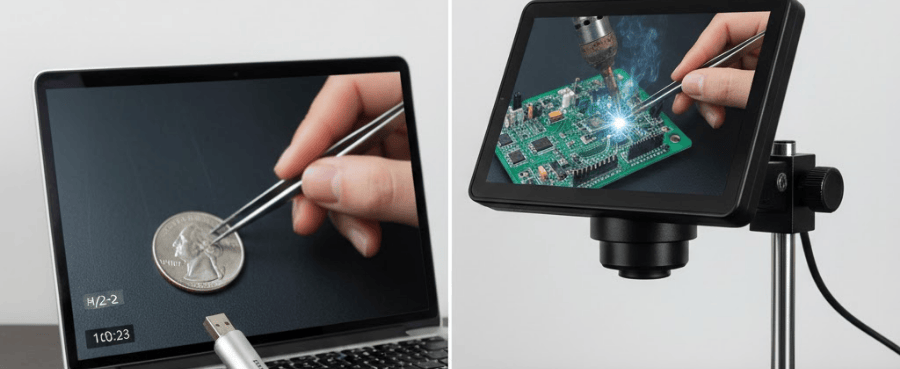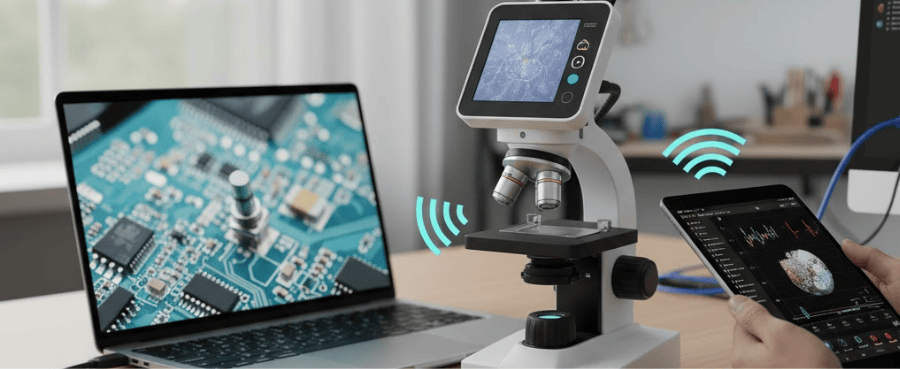"Digital" is the broad category for any scope with a screen, while "USB" is just one specific type that must plug into your computer.
This guide cuts through the jargon to compare PC-dependent USB models against standalone digital units (with their own screens!). We’ll help you ditch the confusion, avoid buyer's remorse, and confidently choose the perfect tool for your coins, circuits, or classroom.
Quick Comparison: Digital vs USB Microscopes
|
Feature |
USB Microscope (PC-Dependent) |
All-in-One Microscope (Standalone) |
|
How it Works |
Plugs into PC/Phone via USB |
Works right out of the box |
|
Screen |
Your computer monitor |
Small built-in LCD screen |
|
Ease of Use |
Can be difficult (drivers, software) |
"Plug and Play" (very easy) |
|
Latency (Lag) |
High Risk: Common on cheap models |
Very Low to Zero |
|
Cost |
Generally cheaper ($30 - $80) |
More expensive ($100 - $300+) |
|
Best For |
Static inspection, hobbyists on a budget |
Active work, soldering, ease of use |
Head-to-Head Comparison: USB vs. All-in-One (Standalone)
The USB Microscope (PC-Dependent)
These are the small, often handheld "camera-on-a-stick" devices. They are completely dependent on your computer for power and display.
Pros:
- Low Cost: This is the most affordable way to get a magnified digital view.
- Big Screen: You get to use your large, high-resolution computer monitor as the display.
- Portable: The device itself is small and easy to carry with a laptop.
Cons:
- The Lag Problem: This is the number one complaint. Many USB models have a noticeable delay between your physical movement and what you see on screen. This makes precision work like soldering impossible.
- "Software & Driver Hell": You can waste hours trying to find the right software or get your PC to recognize the device.
- Wobbly Stands: Many are bundled with flimsy, unstable plastic stands that make focusing a nightmare.
The All-in-One Digital Microscope (Standalone)
These are complete desktop units, like many Tomlov digital microscope models, that include a camera, a stand, and a built-in LCD screen
Pros:
- Zero Lag: What you see is happening in real-time. This is essential for any hands-on work.
- "Plug and Play" Simplicity: Turn it on, and it works. No drivers, no software, no PC needed.
- Stable: They almost always come with a sturdier metal stand and base, making them more stable.
- Easy Photo/Video Capture: Most have an SD card slot, letting you save images and videos with the press of a button.
Cons:
- Higher Cost: You're paying for the convenience and the built-in screen.
- Smaller Screen: The built-in screen (usually 4 to 7 inches) is much smaller than a computer monitor.
- Less Portable: This is a desktop unit, not something you toss in a bag.
Related Reading: What are the main differences between different types of microscopes?

Which is Best for Your Specific Task?
For Electronics Repair & Soldering
- Your Biggest Need: Zero latency (no lag) and a large working distance (space to fit your soldering iron).
- Winner: The All-in-One Digital Microscope. The lack of lag is non-negotiable.
- Pro Tip: Look for a standalone model with a tall stand to maximize your working distance. Even better, get one with an HDMI output (we'll cover this later) to connect to a big monitor for a lag-free view.
For Coin & Stamp Collecting (Inspection)
- Your Biggest Need: High image quality (resolution) and the ability to easily capture photos for documentation or selling.
- Winner: A good USB Microscope. Since the object is static, lag doesn't matter. You can get a high-resolution 5MP or 8MP USB model and use your large 4K monitor to see incredible detail for a low price.
- Pro Tip: Spend the money you saved on a model that comes with a heavy, stable metal stand. A wobbly stand will ruin your focus and photos.
Related Reading: What microscope is best for coins?
For General Hobbies, Insects, or Kids
- Your Biggest Need: Ease of use and "plug-and-play" simplicity.
- Winner: The All-in-One Digital Microscope. The ability to just turn it on and have it work immediately makes it a far better experience for quick inspections or educational fun.
Buyer's Guide: 5 Common Mistakes & How to Avoid Them
Mistake 1: Ignoring Latency (Lag)
You buy a cheap USB scope for soldering. You try to touch a component, but the image on your screen is half a second behind your hand. The tool is useless.
- How to Avoid: If you are performing any active work, you must prioritize a zero-lag system. This means an All-in-One or an HDMI-out model.
Mistake 2: Forgetting "Working Distance"
You get your microscope, but it can only focus when the lens is one inch from your object. You have no room to fit your tools, or even to flip a coin over.
- How to Avoid: Check the specs for "working distance" or "object distance." For any hands-on work, you need at least 2-4 inches of clear space.
Mistake 3: Believing the "1000x Magnification" Hype
You see a $30 microscope advertising "1000x magnification" and assume it's better than a $150 one at "200x."
-
How to Avoid: This is almost always useless "digital zoom" (like zooming in on a blurry photo). What you really care about is Optical Resolution (Megapixels) and Sensor Quality. A 5MP camera at 200x optical zoom is infinitely better than a "1000x" microscope with a 1MP sensor.

Mistake 4: Expecting a 3D View
You get your scope, but you find it hard to judge depth. You can't tell if your soldering iron is above the pin or on it.
- How to Avoid: Understand that all digital and USB microscopes use one camera, giving you a "flat" 2D image. If you need true 3D depth perception, you must upgrade to a Stereo Optical Microscope (a traditional microscope with two eyepieces).
Mistake 5: Ignoring the Stand Quality
You get your scope, but the slightest vibration on your desk (or even your breathing) makes the image shake uncontrollably.
- How to Avoid: The stand is just as important as the camera. Always opt for a model with a heavy, stable metal base and stand.
Practical Tips & Pro-Level Upgrades
How to Set Up a USB Microscope (Without the Headache)
If you do choose a USB model, here's how to avoid the "driver hell":
- Plug it in first: Connect the USB cable to your computer before opening any software.
- Try Built-in Software:
- Windows: Open the built-in "Camera" app. It will often recognize the microscope automatically.
- Mac: Open "Photo Booth" or "QuickTime." The microscope should be listed as a camera source.
- Use Third-Party Software: If the built-in apps don't work, download a simple, free viewer like "AMCap" or the manufacturer's specific software.
- Focus: Place an object under the lens and slowly turn the focus dial on the microscope itself (not in the software) until the image is sharp.
The "Best of Both Worlds": HDMI Digital Microscopes
Many "All-in-One" models also come with an HDMI-out port. This is a killer feature. It lets you bypass the small built-in screen and connect directly to a large TV or desktop monitor for a massive, crystal-clear, zero-lag view. This is the ideal setup for serious electronics work.
Final Decision Guide: Which Should You Buy
What is my primary task?
- A) Active Work (soldering, repair, model building) -> Go to Step 2.
- B) Static Inspection (coins, stamps, insects, documents) -> Go to Step 3.
(Active Work)My work is active, so I need zero lag.
- My Choice: An All-in-One Digital Microscope. If my budget allows, I'll get one with an HDMI output to connect to a large monitor.
(Static Inspection): My work is static, so lag doesn't matter. What's more important?
A)Budget and a Big Screen: I'm on a budget, and I'm comfortable with my PC.
- My Choice: A high-resolution USB Microscope. I'll make sure to get one with a sturdy metal stand
B) Simplicity and Ease of Use: I just want it to work out of the box.
-
-
My Choice: An All-in-One Digital Microscope.
-
Frequently Asked Questions (FAQs)
Q1: Can a USB microscope connect to a TV?
Not directly. USB microscopes are for computers/phones. To connect to a TV, you need an All-in-One Digital Microscope that has an HDMI output port.
Q2: Why is my USB microscope so laggy?
The lag (latency) comes from the time it takes your computer to process the video data from the USB port. Cheaper scopes and slower computers make this delay worse. All-in-one models process the image on the device itself, which is why they have no lag.
Q3: What's a good magnification? Do I need 1000x?
No. "1000x" is almost always a fake marketing number (digital zoom). For most hobbyist work (soldering, coins), a good quality 50x to 300x optical zoom is more than enough. Focus on sensor quality (megapixels) and lens quality, not the "x" number.
Q4: Why does my image look "flat"?
All digital and USB microscopes use a single camera, which produces a 2D image. This "flat" view can make it hard to judge depth. To get a true 3D view, you need a traditional stereo optical microscope (which uses two eyepieces).
Q5: Can I use a USB microscope with my phone?
Yes, many USB microscopes work with Android phones via a USB-C or Micro-USB adapter (and a special app). It's less common and more difficult with iPhones. However, a Wi-Fi microscope is a better (though often laggy) option if your main goal is phone connectivity.
In Conclusion
For active work like soldering, the All-in-One Digital Microscope is the clear winner, giving you the lag-free, "plug-and-play" experience you need.
For static inspection, like coins or stamps, a high-quality USB Microscope is a fantastic, budget-friendly choice that leverages your big computer screen.
Now we want to hear from you! What's your project? Did this guide help you decide? Share your plans or any remaining questions in the comments below—we'd love to know whether you're grabbing a standalone model for your workbench or a USB model for your coin collection!



Laisser un commentaire
Tous les commentaires sont modérés avant d'être publiés.
Ce site est protégé par hCaptcha, et la Politique de confidentialité et les Conditions de service de hCaptcha s’appliquent.